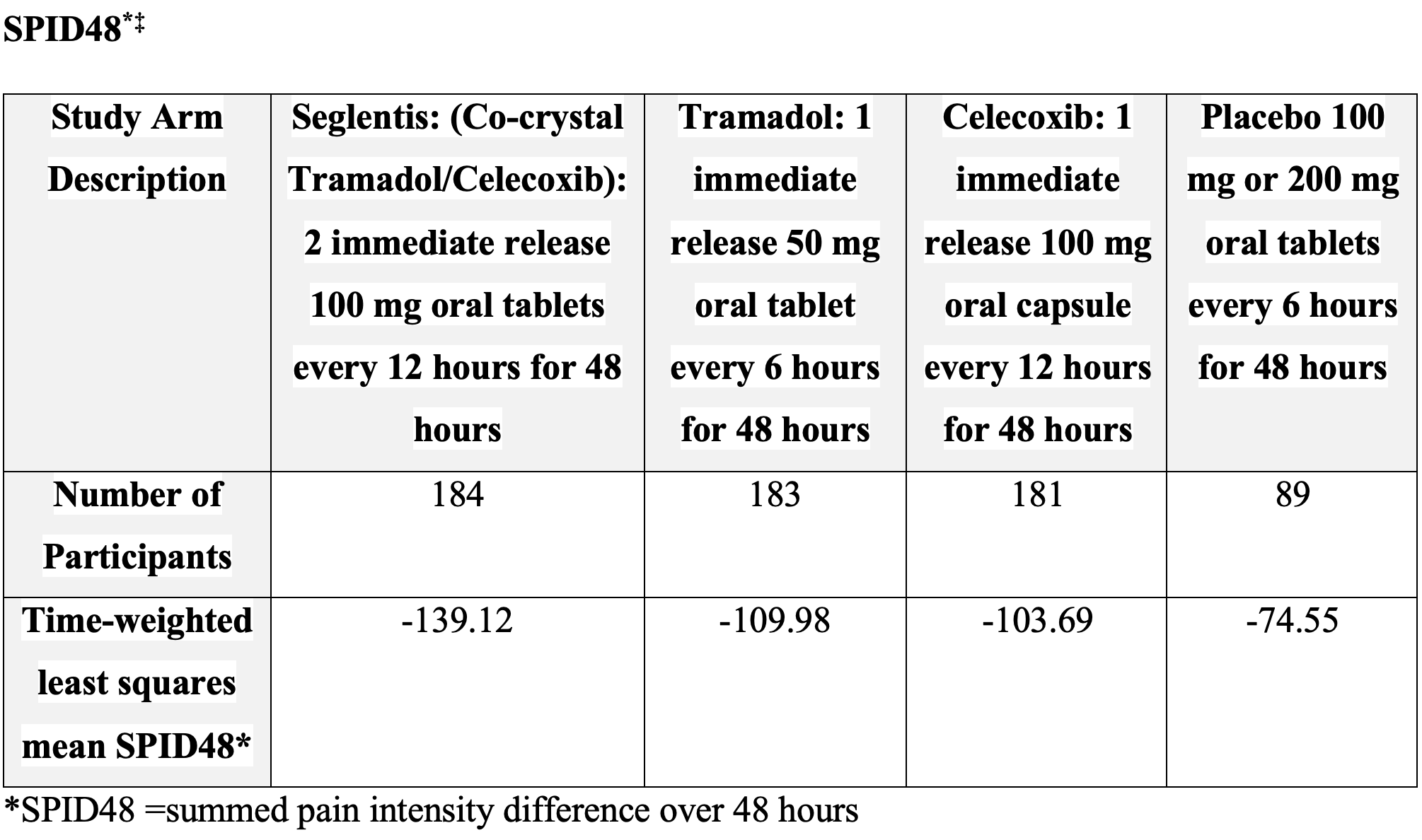Article
Clinical Overview: Exploring the Impact of Co-Crystal Celecoxib and Tramadol Combination
Author(s):
Combining tramadol and celecoxib into a co-crystal of celecoxib-tramadol provides peripherally and centrally mediated analgesia.
The National Institutes of Health report that pain is the most common reason for seeking medical care.1 Data from 2012 estimated that 126.1 million adults in the United States suffer from pain,2 which can be nociceptive (from tissue injury), neuropathic (from nerve injury), or nociplastic (from a sensitized nervous system). There is also overlap in the different types of pain.3
Multimodal therapy to treat pain isdefined by the International Association for the Study of Pain as the concurrent use of separate therapeutic agents with different mechanisms of action. This combination of agents is aimed to address different pain mechanisms.4,5 Co-crystal formulations can be considered a multimodal therapy.
The FDA defines co-crystals as crystalline materials composed of 2 or more different molecules in the same lattice.6 Combining tramadol and celecoxib into a co-crystal of celecoxib-tramadol (CTC) provides peripherally and centrally mediated analgesia.4
MECHANISM OF ACTION
CTC (Seglentis; Kowa Pharmaceuticals America, Inc) is an FDA-approved Schedule IV controlled substance. It is indicated for the management of acute pain in adults that is severe enough to require an opioid analgesic and for which alternative treatments are inadequate.
The mode of action of tramadol is not completely understood. It is believed to be due to binding to mu-opioid receptors and weak inhibition of reuptake of norepinephrine and serotonin. The mechanism of action of celecoxib is believed to be due to inhibition of prostaglandin synthesis, primarily via cyclooxygenase-2 (COX-2).7
DOSING AND ADMINISTRATION
CTC contains celecoxib 56 mg and tramadol hydrochloride 44 mg. Initiate treatment with 2 tablets every 12 hours as needed for pain relief. When starting treatment with this celecoxib-tramadol tablet formulation, consider the pain severity, patient response, prior analgesic treatment, and risk factors for addiction, abuse, and misuse.
The full prescribing information recommends to discuss availability of naloxone with the patient. CTC should be used for the shortest duration aligned with patient treatment goals.7
CLINICAL TRIALS
The efficacy and safety of CTC was evaluated in a randomized, double-blind, parallel group study comparing CTC to tramadol, celecoxib, and placebo for acute pain after bunionectomy with osteotomy (bone cutting procedure). The study enrolled patients ≥18 years of age with acute postoperative pain (rated >5 and <9 on a 0-10 Numeric Pain Rating Scale [NPRS]). Patients had a mean baseline pain intensity of 6.7 on the NPRS.7
The primary efficacy endpoint was time-weighted summed pain intensity difference over 48 hours (SPID48). Researchers reported patients in the CTC group had statistically significantly better mean SPID48 scores than any of the other groups after bunionectomy.7
Negative differences in the score corresponded to an amelioration of pain. The total scale ranged from -480 (best) to +480 (worst). A higher negative value of SPID indicated greater pain relief (Table 1).8
Table 1. Outcome Measures8

ADVERSE EVENTS (AEs)
The most common AEs with incidence greater than 5% in adults taking CTC are nausea, vomiting, dizziness, headache, and somnolence. There is a boxed warning in the FDA-approved label that describes the risks of addiction, abuse, and misuse. The celecoxib-tramadol tablet is available under the Opioid Analgesic REMS (Risk Evaluation and Mitigation Strategy) program.7
The boxed warning also includes cardiovascular thrombotic events and risk factors for life-threatening respiratory depression in children. It also describes gastrointestinal bleeding, ulceration, and perforation.
Cytochrome P450 interactions and risk with concomitant CNS depressants are also explained. Due to the large volume of information in the boxed warning, pharmacists should refer to the full prescribing information for comprehensive details.7
CTC is contraindicated in ages <12 years of age and during postoperative management in children younger than 18 years of age following tonsillectomy and/or adenoidectomy. It should not be used in CABG surgery or in individuals with acute or severe bronchial asthma.
CTC is contraindicated with gastrointestinal obstruction and with monoamine oxidase inhibitors (MAOIs) within the past 14 days. It should not be used in individuals with urticaria or other allergic reactions after taking aspirin or other nonsteroidal anti-inflammatory agents. Additional warnings include serotonin syndrome, risk of seizure, risk of suicide, adrenal insufficiency, renal and hepatotoxicity.7
SPECIAL POPULATIONS
There is a risk of fetal harm with CTC in pregnant women. Breastfeeding is not recommended. The safety and efficacy of CTC in pediatrics has not been established. Elderly individuals taking nonsteroidal anti-inflammatory agents are determined to be at greater risk for serious AEs so individuals taking CTC should be monitored.7
In summary, despite the availability of multiple pharmacotherapies, many individuals
continue to suffer in pain. Because pain can involve multiple mechanisms, combining products with different mechanisms of action, or in the form of a co-crystal formulation, may be a therapeutic option.
References
- Pain. National Institutes for Health. National Center for Complementary and Integrative Health. Updated June 3, 2022. Accessed June 3, 2022. https://www.nccih.nih.gov/health/pain
- Nahin R. Estimates of pain prevalence and severity in adults: United States, 2012. J Pain. 2015;16(8):769-780. doi:10.1016/j.jpain.2015.05.002
- Cohen S., Vase L., Hooten W. Chronic pain: an update on burden, best practices and new advances. Lancet.2021;397(10289):2082-2097. doi: 10.1016/S0140-6736(21)00393-7
- Almansa C, Frampton C, Vela J, Whitelock S, Plata-Salamán C. Co-crystals as a new approach to multimodal analgesia and the treatment of pain. J Pain Res.2019;12:2679–2689
- Raffa R, Pergolizzi J Jr., Tallarida R. Analgesic combinations. J Pain.2010;11(8):701–709. doi:10.1016/j.jpain.2009.12.010
- Regulatory classification of pharmaceutical co-crystals guidance for the industry. US Food and Drug Administration. February 2018. Accessed 6/3/2022. https://www.fda.gov/media/81824/download
- Seglentis. Prescribing information. Kowa Pharmaceuticals America, Inc.; 2021. Accessed June 1, 2022. https://www.kowapharma.com/documents/SEGLENTIS_Prescribing_Information.pdf
- Seglentis. Efficacy demonstrated in the phase 3 clinical trial. Kowa Pharmaceuticals America, Inc. May 2022. Accessed June 1, 2022. https://www.seglentis.com/clinical-data/efficacy
Newsletter
Stay informed on drug updates, treatment guidelines, and pharmacy practice trends—subscribe to Pharmacy Times for weekly clinical insights.






